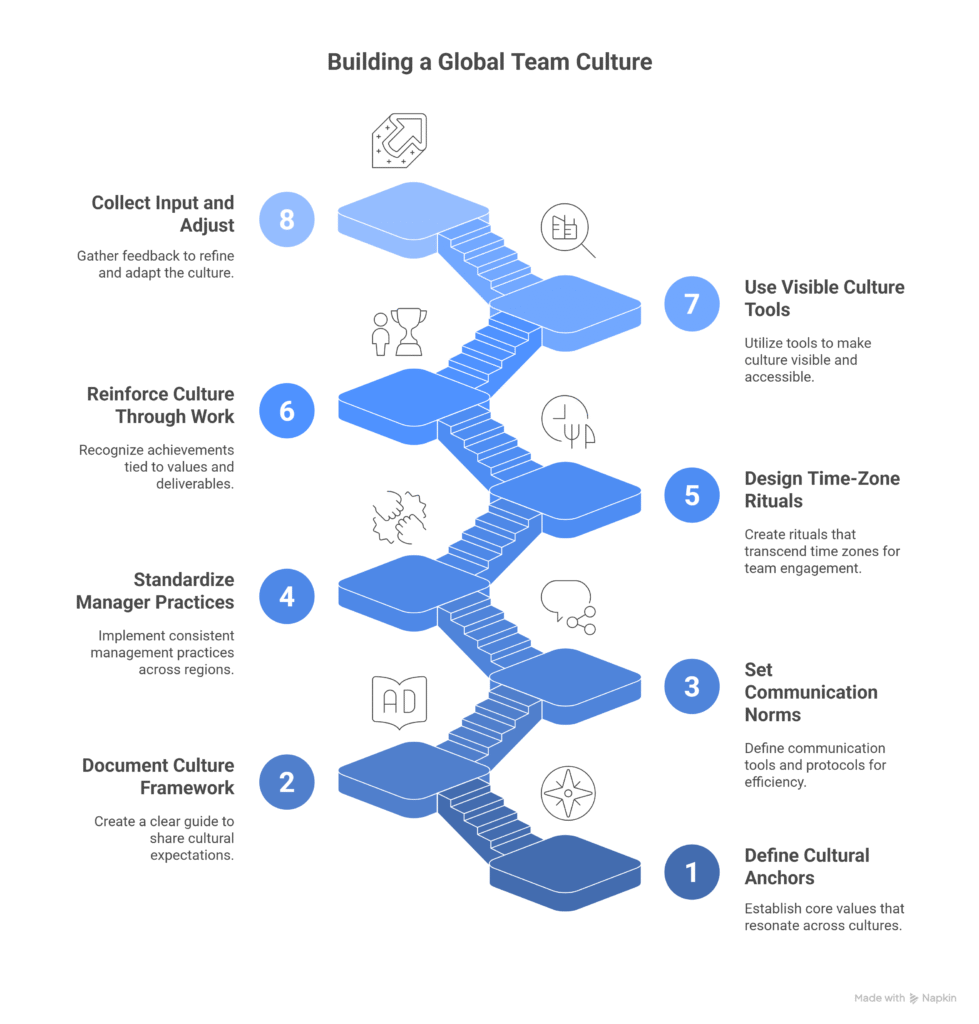Building a strong remote work culture across time zones is essential for maintaining collaboration, productivity, and employee satisfaction. As businesses expand globally, you face unique challenges in fostering connection among team members who may never meet in person. Miscommunication, cultural differences, and varying schedules can disrupt workflows if not addressed effectively.
To create a cohesive environment, you need strategies that prioritize clear communication, inclusivity, and shared values. Leveraging tools like video conferencing platforms and project management software helps bridge gaps while promoting transparency. By focusing on trust and engagement, you can align your team’s goals even though geographical barriers.
How do you ensure your remote workforce feels connected and motivated no matter where they are?

Step 1: Define Cultural Anchors That Translate Across Borders
Establishing cultural anchors ensures your remote team shares a unified identity, regardless of location. These anchors should resonate universally and align with your company’s mission.
Focus on operational values: ownership, clarity, speed
Operational values like ownership, clarity, and speed create consistency in distributed teams. Ownership empowers employees to take responsibility for outcomes without micromanagement.
Clarity minimizes miscommunication by setting explicit expectations across time zones. Speed prioritizes efficiency while respecting regional workflows. For example, when hiring offshore developers or managing international hires, these values help streamline collaboration and decision-making processes.
Embed these principles into onboarding materials and performance reviews to reinforce alignment across global regions. This approach supports scalable operations with remote hiring while maintaining productivity standards.
Align team behavior expectations with company goals
Behavioral expectations must reflect organizational objectives to maintain cohesion in a global workforce. Specify how team members should communicate asynchronously, resolve conflicts constructively, and adhere to deadlines even though differing schedules. For instance, when scaling operations with remote hiring or integrating offshore teams into US workflows, consistent guidelines prevent misunderstandings.
Provide training sessions tailored for cross-border recruitment compliance and multi-region talent acquisition challenges. Use examples from successful distributed workforce operations to illustrate best practices that drive long-term success in building borderless hiring pipelines.
Step 2: Document and Share the Culture Framework
A documented culture framework ensures consistency across distributed teams. It aligns offshore employees with your company’s values, streamlining collaboration even though time zone differences.
Create a culture guide that’s accessible and concise
Develop a written guide that outlines core values, communication norms, and behavioral expectations. Include sections on decision-making processes, conflict resolution methods, and preferred tools for remote collaboration. For example, specify how offshore marketers should report progress or how international sales talent can escalate client concerns.
Keep the document brief but comprehensive to avoid overwhelming new hires. Use clear language to make it understandable for global team members who may not share the same native language. Host this guide in an easily accessible location within your remote recruitment infrastructure so all employees can reference it as needed.
Integrate cultural expectations into onboarding
Embed cultural training into your cross-border onboarding process to ensure alignment from day one. Introduce operational values during orientation sessions tailored for managing international hires. For instance, explain how long-term offshore staffing integrates with US-based workflows or highlight time zone-aligned hiring practices for smoother coordination.
Provide real-world examples of acceptable behaviors tied to specific roles—such as offshore recruitment for marketing teams requiring proactive updates or distributed engineering teams prioritizing asynchronous communication. Reinforce these standards through follow-up check-ins during the first 90 days to confirm understanding and address gaps early on.
Step 3: Set Communication Norms Early
Establishing clear communication norms ensures smooth collaboration in distributed teams. Without defined expectations, offshore staffing for US businesses can face delays and misunderstandings.
Define tools, response windows, and escalation paths
Specify the primary tools for team communication to avoid confusion. For example, use Slack or Microsoft Teams for daily updates and Zoom for virtual meetings. Assign each tool a specific purpose to streamline interactions.
Set response time expectations based on overlapping hours. For instance, require replies within four business hours during shared working periods. This reduces bottlenecks when hiring talent across time zones.
Create an escalation path for unresolved issues. Designate roles responsible for addressing critical problems promptly. If a developer in India encounters blockers, ensure they know who to contact immediately to maintain project timelines.
Clarify when to use sync vs async across time zones
Differentiate between synchronous (real-time) and asynchronous (delayed) communication methods. Use synchronous channels like video calls only when immediate feedback is essential, such as resolving urgent client requests with your global delivery teams.
Leverage asynchronous options like email or task management platforms for routine updates or non-urgent discussions. When managing international hires from regions with minimal overlap, async workflows minimize disruptions while maintaining productivity.
Encourage detailed documentation of decisions made asynchronously. This practice benefits long-term offshore staffing by ensuring transparency and accountability even though geographic separation.

Step 4: Standardize Manager Practices Across Regions
Standardizing manager practices ensures consistency in leadership across distributed teams. This approach supports offshore staffing for US businesses by aligning expectations and fostering a unified remote culture.
Use a management playbook for 1:1s, feedback, and reviews
A management playbook creates uniformity in how managers handle key interactions like one-on-ones, performance feedback, and employee reviews. Include structured templates that outline meeting agendas, evaluation criteria, and communication protocols to reduce ambiguity. For example, specify questions managers should ask during 1:1s with offshore employees to address time zone challenges or cultural nuances.
Incorporate guidelines tailored for managing international hires into the playbook. Highlight strategies for giving actionable feedback to team members from diverse backgrounds while respecting local work norms. A standardized review process also ensures fairness when evaluating offshore professionals alongside domestic staff. By implementing these consistent frameworks, you build trust within your global workforce.
Set expectations for cross-border team integration
Clear expectations simplify integrating offshore teams into existing operations. Define roles and responsibilities explicitly during onboarding to avoid confusion about deliverables or reporting structures. When hiring talent across time zones, establish collaboration norms such as overlapping working hours or preferred tools for synchronous meetings.
Provide training on cross-border recruitment compliance and cultural awareness to help managers navigate regional differences effectively. For instance, explain how holidays or workweek schedules vary between regions so deadlines remain realistic. Setting these standards early minimizes friction when scaling operations with remote hiring models and strengthens cohesion among distributed teams operating globally.
Step 5: Design Rituals That Don’t Depend on Time Zones
Creating rituals that transcend time zones strengthens remote team cohesion. These practices ensure inclusivity and engagement, regardless of geographic location.
Async team wins, shoutouts, and retrospectives
Celebrate achievements asynchronously to include all team members across regions. Use shared platforms like Slack or project management tools to highlight individual contributions (e.g., completing a complex offshore development sprint) or group milestones. Create dedicated channels for shoutouts where peers can recognize efforts in real-time without requiring synchronous participation.
Conduct retrospectives using collaborative documents or asynchronous video updates. Ask team members to share insights about what worked well during recent projects, especially when managing international hires or scaling operations with remote professionals.
This approach fosters transparency while respecting varying schedules. By embedding these rituals into your distributed workforce operations, you maintain morale and encourage continuous improvement.
Monthly team updates from leadership with context and priorities
Distribute monthly leadership updates asynchronously to align global teams on goals and progress. Record short videos summarizing key developments—such as expanding offshore employees—or provide written summaries detailing priorities for the upcoming month.
Include specific metrics related to hiring outcomes (e.g., onboarding remote global talent or integrating offshore teams into workflows). Address challenges openly, such as coordinating cross-border recruitment logistics or optimizing performance-driven offshore staffing models.
Offering this clarity ensures every employee understands their role within broader organizational objectives, fostering alignment even though time zone differences.
Step 6: Reinforce Culture Through Work, Not Perks
Focusing on work-driven culture strengthens your team’s connection to shared goals. Perks may attract attention temporarily, but they don’t sustain long-term engagement in distributed teams.
Recognition tied to values and deliverables
Recognize achievements that align with company values and measurable outcomes. Instead of generic praise, highlight specific contributions like meeting tight deadlines during cross-border recruitment compliance or improving offshore team performance tracking. This approach reinforces the behaviors you want replicated across your global workforce.
For example, if an offshore developer optimizes code efficiency for a critical project, acknowledge their impact on operational hiring across continents. Use public channels such as Slack to share these recognitions asynchronously so all team members feel included regardless of time zones.
By tying recognition directly to results, you create a feedback loop that motivates employees while reinforcing organizational priorities.
Promote role clarity and consistent execution
Define roles clearly within your distributed workforce operations to avoid confusion and ensure accountability. For instance, when managing international hires in emerging talent markets, specify responsibilities for each position during onboarding. Use structured documentation accessible through remote-ready recruitment workflows to maintain consistency.
Encourage managers overseeing offshore staffing for US companies to conduct regular check-ins focused on deliverables rather than activity logs. This ensures alignment without micromanagement.
For example, if you’re scaling operations with remote hiring in multiple regions, set clear expectations about reporting formats and timelines upfront. Consistent processes reduce friction and enable seamless collaboration across borders while driving productivity aligned with business objectives.
Step 7: Use Tools That Make Culture Visible
Leverage tools to make your remote culture tangible and accessible. These platforms ensure distributed teams align with shared values, fostering collaboration across time zones.
Maintain an internal wiki with working norms and updates
Create a centralized wiki to document processes, cultural guidelines, and team updates. This resource serves as a single source of truth for employees navigating cross-border recruitment compliance or managing international hires. Include sections on communication protocols, decision-making workflows, and onboarding steps tailored for global team members.
For offshore staffing in US businesses, use the wiki to outline expectations for time zone-aligned hiring practices and project timelines. Add real-time updates about organizational changes or policy adjustments to keep everyone informed. A well-maintained wiki reduces miscommunication when scaling operations with remote hiring by ensuring every employee has access to consistent information.
Use Slack, Loom, or Notion to share context asynchronously
Adopt asynchronous tools for quick discussions, Loom for video explanations, or Notion for detailed documentation. These platforms help bridge gaps in distributed workforce operations without requiring synchronous participation. For example, record Loom videos summarizing key decisions made during leadership meetings so offshore developers or marketing teams can review them at their convenience.
When recruiting internationally for remote roles or building borderless hiring pipelines, these tools streamline communication across regions with low overlapping hours. Share project milestones through Notion pages that integrate seamlessly into your global sourcing strategy while enabling transparency among team members located beyond US borders.
Step 8: Collect Input and Adjust as the Team Grows
Gathering feedback regularly ensures your remote culture evolves with team dynamics. As your distributed workforce expands, refining processes based on actionable insights becomes essential for maintaining alignment.
Run semi-annual culture check-ins with offshore team leads
Schedule biannual sessions to evaluate cultural alignment across global teams. Engage offshore team leads in structured discussions about communication norms, collaboration challenges, and engagement levels. Use these meetings to identify recurring issues impacting productivity or morale within specific regions.
Focus on gathering input related to time zone-aligned workflows, onboarding experiences for international hires, and cross-border recruitment compliance. Document findings systematically to uncover trends affecting long-term offshore staffing success.
For example, if multiple teams report delays due to unclear escalation paths during overlapping hours, prioritize adjustments that streamline decision-making processes globally.
Iterate based on patterns, not one-off feedback
Base changes on consistent patterns observed over time rather than isolated complaints. Analyze aggregated data from employee surveys, performance reviews, and leadership reports to pinpoint systemic gaps in your distributed hiring model or remote team infrastructure.
For instance, if several employees highlight difficulties integrating into a global-first hiring framework due to insufficient training on regional work norms, enhance onboarding materials accordingly. Avoid overreacting to singular grievances unless they reveal broader inefficiencies in managing international hires or scaling operations with remote professionals. By focusing on repeatable trends, you can carry out sustainable improvements that benefit your entire global workforce without disrupting established workflows unnecessarily.
Culture Building Across Time Zones Requires Structure, Not Guesswork
Creating a thriving remote culture across time zones demands intentionality and well-defined strategies. By focusing on clear communication, shared values, and structured processes, you can bridge geographical gaps and foster meaningful connections within your team.
Investing in tools, training, and consistent practices ensures alignment while empowering employees to collaborate effectively. As your team grows, remain adaptable by gathering feedback and refining your approach to meet evolving needs.
A strong remote culture doesn’t happen by chance—it’s built through deliberate efforts that prioritize trust, inclusivity, and accountability. With the right framework in place, you’ll set your global workforce up for long-term success.

Frequently Asked Questions
What is remote work culture, and why is it important?
Remote work culture refers to the shared values, behaviors, and practices that guide a distributed team. It’s essential because it fosters collaboration, trust, and engagement among employees working across different locations and time zones.
How can companies address communication challenges in remote teams?
Companies can address communication challenges by setting clear norms for tools like Slack or Zoom, defining response times based on overlapping hours, and using asynchronous methods with detailed documentation to ensure transparency.
What are cultural anchors in remote work?
Cultural anchors are core values or principles that resonate universally within an organization. They align team behavior with company goals and create consistency across geographically dispersed teams.
Why is onboarding crucial for international hires?
Onboarding ensures new hires understand the company’s culture, communication norms, and expectations from day one. This alignment helps them integrate smoothly into the team and boosts productivity.
How can managers maintain consistency in leadership across regions?
Managers can use standardized playbooks outlining templates for one-on-ones, feedback sessions, and performance reviews. These tools help reduce ambiguity while respecting local cultural differences.
What role do rituals play in strengthening remote team cohesion?
Rituals like celebrating achievements asynchronously or conducting retrospectives via collaborative documents foster connection and inclusivity without requiring synchronous participation.
Which tools are recommended for enhancing remote collaboration?
Tools like Slack (for daily updates), Loom (for video messages), Notion (for documentation), and Zoom (for meetings) improve communication efficiency while bridging gaps in global operations.
How should organizations document their remote culture framework?
Organizations should create an internal wiki or concise guide detailing core values, behavioral expectations, decision-making processes, and conflict resolution methods accessible to all employees.
How can companies measure the effectiveness of their remote culture?
Semi-annual check-ins with offshore leads allow organizations to gather feedback on cultural alignment, communication norms, collaboration challenges, and employee engagement levels for continuous improvement.
Why focus on outcomes rather than micromanaging in distributed teams?
Focusing on deliverables during check-ins avoids confusion about roles while empowering employees to take ownership of their tasks. This approach enhances accountability and productivity globally.




